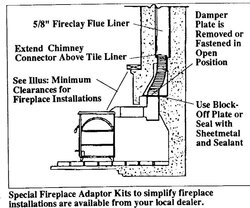We got a new EPA certified Lopi insert last season. Ever since the new insert was installed (by a certified installer) we have had a BIG problem with smell. The fire draws fine when there is fire going and for 24 hours after we have had a fire everything is fine, but 24-48 hours after the fire has gone out the ENTIRE house (small <1200sq ft house) smells like creosote/smoke. There is NO smoke in the house, the fire has been out for over 24hours at this point. We talked to the dealer, they put a little more insulation around the insert which didn't work.
This started happening last season, the weather warmed up and we had not had a fire from last March/April. Then as soon as the weather turned cooler this past fall, without having had a fire since last spring, the smell returned. We contacted the dealer again and they put us in contact with a chimney sweep/expert to clean everything. He advised us the problem is creosote build up and told us to always burn the fire with dampers open so it will burn hot. This helped some but has not eliminated the problem. He said on a scale of 1-10 our build up was a 2 which doesn't seem like it should be causing this big of an issue.
We need help, at this point if it can't get fixed somehow, the stove will have to be re-sold, we can't live with it this way. We are burning through our wood supply like crazy because even on nights where it's relatively warm and we wouldn't necessarily need a fire we are burning one just to prevent the smell from coming back and trying to keep the fire as hot as possible is using up more wood as well. One company told us that getting our chimney (masonry,on outside wall) piped would help? However since that's going to cost a lot of money we want to know that's going to help before we do it. I haven't been able to find anyone else having a similar problem so I don't know if anyone here can help but I wanted to try. We don't want to get rid of the fireplace, we really enjoy wood heat and it's what I grew up with but we have never had a problem like this before.
This started happening last season, the weather warmed up and we had not had a fire from last March/April. Then as soon as the weather turned cooler this past fall, without having had a fire since last spring, the smell returned. We contacted the dealer again and they put us in contact with a chimney sweep/expert to clean everything. He advised us the problem is creosote build up and told us to always burn the fire with dampers open so it will burn hot. This helped some but has not eliminated the problem. He said on a scale of 1-10 our build up was a 2 which doesn't seem like it should be causing this big of an issue.
We need help, at this point if it can't get fixed somehow, the stove will have to be re-sold, we can't live with it this way. We are burning through our wood supply like crazy because even on nights where it's relatively warm and we wouldn't necessarily need a fire we are burning one just to prevent the smell from coming back and trying to keep the fire as hot as possible is using up more wood as well. One company told us that getting our chimney (masonry,on outside wall) piped would help? However since that's going to cost a lot of money we want to know that's going to help before we do it. I haven't been able to find anyone else having a similar problem so I don't know if anyone here can help but I wanted to try. We don't want to get rid of the fireplace, we really enjoy wood heat and it's what I grew up with but we have never had a problem like this before.




 and have him pull the insert, completely clean the entire interior (smoke chamber and clay liner,) put in a liner and block-off plate and do the rest of what was suggested above, then it should be pretty close.
and have him pull the insert, completely clean the entire interior (smoke chamber and clay liner,) put in a liner and block-off plate and do the rest of what was suggested above, then it should be pretty close.